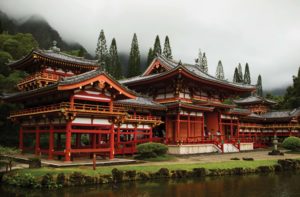That Doris Duke’s home is being opened to tours is entirely in keeping with not only her wishes, as recorded in her will, but her practice in life.
Although she was an extremely private person, the late heiress took great pride in Shangri La, her Black Point mansion near Diamond Head on Oahu, and the objects she collected there. Her neighbor and friend of 20 years, actor-singer Jim Nabors, thinks that perhaps this is because her other homes were inherited, but this one she built herself. She told him often about her plans to make it a public place.
Jin de Silva, who for more than a decade was the caretaker of the property and Duke’s partner in many Shangri La art projects, recalls that the woman he still respectfully calls “Miss Duke” delighted to give first-time visitors a tour. She would tell the story of each collected piece, each architectural innovation and each purposeful arrangement.
In the rise-and-fall accent of his native Sri Lanka, de Silva described those glory days: “If you visited the house in the evening, I would be meeting you at the door and taking you into the living room, and then I would go and tell Miss Duke that you had arrived. She would come and greet you and I would bring drinks, and she would be always talking of all this, telling you about her things. That is the way she enjoyed her life.”
Deborah Pope, executive director of Shangri La, said Duke’s intent was to make her Hawaii retreat not merely an attraction for gawkers but, as the will says, “a center for the study and understanding of Middle Eastern art and culture.”
In escorting visitors around her home, Duke invited them to share her vision, which marries Middle Eastern ideas about light, space and patterns with Hawaii’s welcoming climate, both materially and in our ways. Nabors said she found a spirituality here that she encountered nowhere else.
The Shangri La tours begin at the Honolulu Academy of Arts, where the Doris Duke Foundation for Islamic Art has endowed a new Arts of the Islamic World Gallery, and where a short but revealing orientation film will set the stage before vanloads of 12 visitors each head out to the house for a 1 1/2-hour tour.
Started With a Honeymoon
You learn, if you did not already know, that Duke, an heiress orphaned when she was 12, married at 23 a man considerably older than herself. He would later fade from the picture, but in 1935 the two embarked on an around-the-world honeymoon that included the Middle East. There, the bride was so taken with what she saw that she commissioned a marble bedroom and bathroom suite patterned after ideas she had encountered in the palaces of the Mogul emperors in India.
Headed home, the couple made an extended stay in Hawaii, where Duke found another lasting interest.
Duke was the Jackie Onassis of her day, an object of ceaseless interest to paparazzi and tabloid readers, who were fascinated by the doings of a woman so young and so rich.
In the Islands, however, she was given a measure of peace and space. The athletic socialite made friends, most famously with the Kahanamoku brothers of beachboy fame, who taught her to surf. She was nicknamed “Lahilahi,” meaning fragile, for her wispy voice and slight figure.
In 1936, she bought the land that would become Shangri La, and for the next 56 years, until her death in 1992, she worked on the home.
What may have seemed the whim of someone rich enough to conjure up whatever she wished — including an Islamic pleasure palace on the shore near where Waikiki is now, through the power of Duke’s fortune and her considerable will, a means of assuring that visiting scholars, artists and any interested visitor can be introduced to her unique vision.
A True Lover of Art
Duke was a collector, patron and maker of art.
She gathered pieces ranging from a single decorative tile to an entire 19th-century Damascus house, which she had dismantled, salvaging its painted panels to line the walls of her Turkish Room. In the living room, the carved marble fireplace was purchased at auction from the leavings of William Randolph Hearst’s bankruptcy.
She had, said Pope, a collector’s eye and the ability to make “curatorial decisions,” with the help, over the years, of curators, architects, auction houses, artists and artisans around the world.
“When she found something she wanted to learn about, like Islamic art, she would hire the best scholars to teach her,” Nabors recalled.
Duke also employed an estate manager, Violet Mimaki, who between 1968 and 1986 created a detailed file-card record of every object and furnishing in the house; documentation better than that found in some museums, Pope said, although mysteries persist about the origins of many pieces.
Duke might install an object on a shelf behind glass, but she was just as likely to affix it to a wall in a particular pattern, or cut it apart to fit into some mosaic of her own devising. She sometimes spent weeks pondering the positioning of a grouping — like a child playing, said de Silva affectionately.
“She really enjoyed what she did, and she was somewhat of an artisan herself,” recalled Nabors.
One example of her ability to recognize an exceptional piece, and how to display it, Pope said, is the magnificent mihrab, a tile prayer niche designed to help the worshipper find the direction of Mecca, as Islamic doctrine requires.
Duke placed it so that it is framed in a successive vista of doorways and windows and visible all the way across the lawn. Aquamarine, azure, gold and burnt sienna glow dully and draw the eye, as she intended. This piece had to be quickly torn off the wall and hidden in the basement during World War II, as were many treasures.
Duke and de Silva worked three years on the elaborate Turkish or Damascus Room, a tile-floored retreat lined with painted panels and various artworks, and a fountain of her own design.
Duke didn’t just give directions and then go out to lunch; she toiled alongside her hired helpers, cleaning grime from tiles and wood panels, supervising the cutting of marble just so. This room is not on the tour but will be later.
Final Project Unfinished
Duke’s last project was a grouping of tiles cemented into a stucco wall in the passage between the living room and dining room.
De Silva recalls how she called for the miscellaneous pieces: “Where are my tiles? Why are you always hiding my tiles from me?”
The tiles aren’t related, but Duke had ideas for placing them in relationships. However, she was unable to finish the project before she left Shangri La that year — she generally spent the winter and early spring here: and then she fell ill. The last spot remains unfilled.
The heiress took what was before her including the 4.9 acres that became Shangri La and did with it what she willed. It took two years for workers and earthmovers to turn a sloping beachfront into what appears from the sea to be a Moorish fortress. A breakwater creates a calm enclosure for swimming, and the increased elevation assures a long view of the shore, from an odd, rippled perspective of one side of Diamond Head to East Honolulu’s curving shore.
One way that Duke took an Islamic approach to the house is in the blank face it shows to those who have not yet been invited in. The dozen tourists delivered by minivan will enter by an anonymous gate. Arriving at the courtyard parking area, you encounter only blank white wall and the huge wooden front door, a 19th-century piece from Egypt or Syria, which bids guests in carved Arabic, “Enter herein in peace and security.”
Throughout the house, rooms are walled off from each other, or glimpsed through teasing vistas — a door, a carved window or screen. In the entryway, for example, you can hear water music from the fountain in the courtyard beyond, but your view is cut off by a carved black screen, allowing only a fragmented impression of color and light.
“Each room,” says architect Kazi Ashraf in the opening film, “is a different world.”








